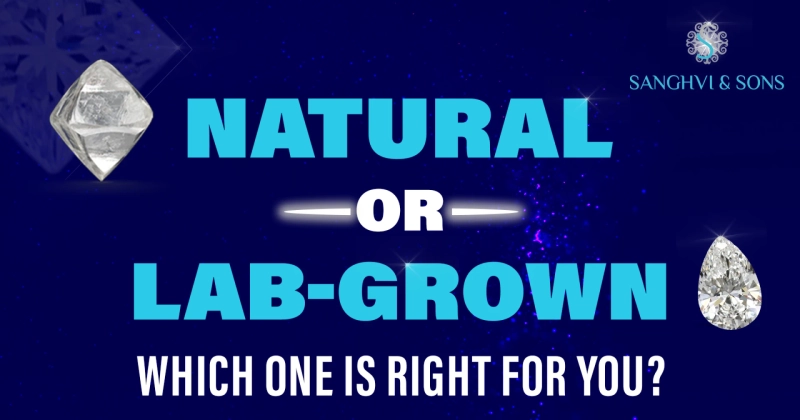Diamonds are one of the most beloved and cherished gemstones in the world. However, there are two different ways to obtain diamonds: natural and lab-grown. Natural diamonds are created by nature over millions of years, while lab-grown diamonds are created in a laboratory setting. Both types of diamonds have their unique characteristics, benefits, and drawbacks, making them a popular choice for consumers worldwide.
In this discussion, we will explore the differences between natural and lab-grown diamonds, and how they compare in terms of cost, quality, environment and sustainability. So whether you’re in the market for a diamond engagement ring or just curious about these sparkling gems, read on to learn more about the world of diamonds!
How are diamonds made?
Both natural and lab-grown diamonds are made of carbon atoms arranged in a crystal lattice structure, but the processes for creating them are different.
Natural diamonds are made deep within the Earth’s mantle, under high pressure and temperature. It’s like baking a cake, but instead of using an oven, the Earth uses pressure and heat to bake diamonds over millions of years. These diamonds are then brought to the Earth’s surface by volcanic eruptions.
Lab-grown diamonds, on the other hand, are created by scientists in a lab. It’s like making a cake in a microwave. Scientists use machines to mimic the Earth’s high pressure and temperature conditions to make diamonds grow from tiny seeds. It’s much faster than waiting for millions of years like natural diamonds, and it’s also more eco-friendly.
Both natural and lab-grown diamonds are made of carbon atoms, so they look and feel the same. However, lab-made diamonds are often more affordable than natural ones because they don’t take as long to make, and they are a more sustainable option.
What are diamonds made of?
Diamonds are made of just one element: carbon! Yes, the same carbon that’s in pencils, coal, and even our bodies. But the carbon atoms in diamonds are arranged in a unique way that gives them their incredible hardness and sparkle.
In nature, diamonds are formed deep beneath the Earth’s surface, where the pressure and temperature are extremely high. Under these conditions, carbon atoms bond together in a crystal lattice structure to form a diamond. This process takes millions of years and requires just the right conditions, which is why diamonds are so rare and valuable. In a lab, scientists can replicate these conditions to create lab-grown diamonds. By exposing carbon to high pressure and high temperature or a carbon-rich gas, they can grow diamond crystals in just a few weeks or months.
So the next time you admire a diamond’s beauty, remember that it’s made of something as simple as carbon, but arranged in a way that makes it one of the most precious and coveted materials in the world.
Natural diamonds can also come in a range of colors, including colorless or white, yellow, brown, and even pink or blue. These colors are caused by the presence of trace elements or structural defects within the crystal lattice. Natural colored diamonds are rarer and more valuable than colorless diamonds.
Natural v/s Lab Grown Diamonds Price
Natural diamond prices and lab-made diamonds can vary significantly, depending on a variety of factors, including size, quality, and market demand. In general, lab-grown diamonds are typically less expensive than natural diamonds of similar quality and size. One of the main reasons for this price difference is that natural diamonds are rare and difficult to mine, which drives up their cost. The natural diamond price is also affected by market demand, with certain sizes and qualities being more in demand than others. This can lead to significant price fluctuations over time.
In contrast, lab-grown diamonds can be produced in a controlled environment, which reduces the costs associated with mining and processing Lab-grown diamond prices are largely determined by the cost of production, which is influenced by factors such as the type of technology used, the quality of the equipment, and the availability of resources such as energy and water.
Overall, lab-grown diamonds are typically less expensive than natural loose diamonds, but the price difference can vary depending on the specific characteristics of the diamonds and market conditions. Consumers should carefully consider their budget and priorities when deciding between natural and lab-grown diamonds.
See more:
Online Diamond Shopping: How to Do it? What Is the Buying Process?
Natural diamonds vs lab-grown diamonds: which is better?
The answer to the question of which is better, natural diamonds or lab-grown diamonds, depends on a variety of factors, including personal preferences, budget, and intended use.
Natural diamonds are rare and have been highly valued for centuries, making them a symbol of luxury and prestige. However, natural loose diamonds are also associated with ethical and environmental concerns, including labour exploitation, environmental damage, and conflict financing. Additionally, natural diamonds can be more expensive due to their rarity and the costs associated with mining and processing
Lab-grown diamonds offer a more sustainable and ethical alternative to natural diamonds. They are created in a controlled environment, using less energy and water than mining and processing natural diamonds. Lab-grown diamonds are also typically less expensive than natural diamonds, making them more accessible to consumers.
However, man-made diamonds are not without their drawbacks. They may lack the sentimental value and historical significance associated with natural colored diamonds. Additionally, some consumers may prefer the natural beauty and unique characteristics of natural diamonds over the uniformity of lab-grown diamonds.
If you are looking for natural loose diamonds, visit Sanghvi & Son’s website, we have been securely providing top-notch quality for the past 30 years all over the world. We are the best diamond exporter in India to deliver the perfect gems to celebrate your every occasion.
Read : How to Become a Diamond Merchant in India


